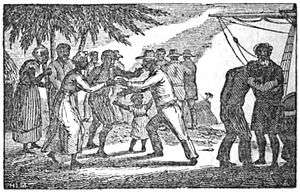Liberated Africans in Sierra Leone
Following the British abolishment of the slave trade, the British began to capture slave ships in the Atlantic Ocean on a mission to rescue Africans from the Middle Passage. The Africans, who became known as The Sierra Leone Liberated Africans, featured a diverse history across the continent. Perhaps better classified as "recaptives," the so-called liberated Africans had indeed been saved from the Transatlantic Slave Trade but were in many ways captives in their own continent. Rather than be allowed to return home, the recaptives were brought to foreign land far from their family, friends, or familiar cultures. Instead of being rescued, the recaptives entered into a system of coerced labor with little liberation in Sierra Leone.

Background
After the British outlawed the slave trade in 1808, the Royal Navy started patrolling along the African coast and high seas, seizing all slave vessels. They transported most liberated Africans to Freetown, but sent some to Liberia, a colony established by the United States; Saint Helena, Guyana in South America, and the British West Indies. Over 40,000 liberated Africans arrived in Freetown between 1808 and about 1855. They were given land, baptised and given Christian first and last names.
The liberated Africans came from all over West Africa and some Central African countries; of the people who settled in Freetown, however a significant portion of the Recaptives settled in Freetown were Bakongo, Beninese, Yoruba, Igbo, Hausa and Akan.
Recaptive Life in Sierra Leone
While information on the day-to-day lives of the recaptive Africans living in Sierra Leone is scarce, there remains registers of Africans recaptured by the British, letters written to the governor, and other sources that allow the present to understand the lives of the Africans forced to remain there.
In the registers kept by the British, many of the African names were changed to European ones, highlighting the transition to their new circumstances in a British colony.[1] Through the registers, it is clear that recaptives were forced to be apprentices to Europeans and often and sold as apprentices.
Liberated African Villages
A number of villages were established to provide accommodation for these new residents of Sierra Leone.
- 1809 Leicester
- 1810 Wilberforce formerly Cabenda
- 1812 Regent
- 1816 Gloucester
- 1816 Kissy
- 1817 Bathurst (originally called Leopold)
- 1817 Charlotte
- 1819 Hastings
- 1819 Waterloo
- 1819 Wellington
- 1829 Murray Town
- 1829 Aberdeen
Formation of Sierra Leone Creole people
The Colony-born children of Liberated Africans, the Jamaican Maroons and Nova Scotian Settlers sometimes called the liberated Africans "Willyfoss niggers".[2] Nevertheless, after several decades all three groups developed into the Sierra Leone Creole people who became recognised as a particular ethnic identity alongside others in Sierra Leone.
See also
References
- ↑ Schwarz, Suzanne (2012-01-01). "Reconstructing the Life Histories of Liberated Africans: Sierra Leone in the Early Nineteenth Century". History in Africa. 39: 175–207. doi:10.1353/hia.2012.0011. ISSN 1558-2744.
- ↑ A history of the colonization of ... - Google Books. Books.google.com. Retrieved 2011-02-25.
Sources
- http://www.urc.org.uk/reform_magazine/articles/clapton/growing.htm
- http://www.ihaystack.com/authors/h/james_holman/00012528_a_voyage_round_the_world_vol_i_of_/00012528_english_usascii_p005.htm
- http://www.yorku.ca/nhp/seminars/seminars/schuler.doc
- http://www.ehess.fr/centres/ceifr/assr/N117/03.pdf (no longer available)
- "History of Creoles of Freetown", AfricaMedia
External links
- http://www.slbtbhm.homestead.com/KDY.html
- http://www.homestead.com/sierraleoneprayergroupuk/
- http://www.slbtbhm.homestead.com/HOME.html